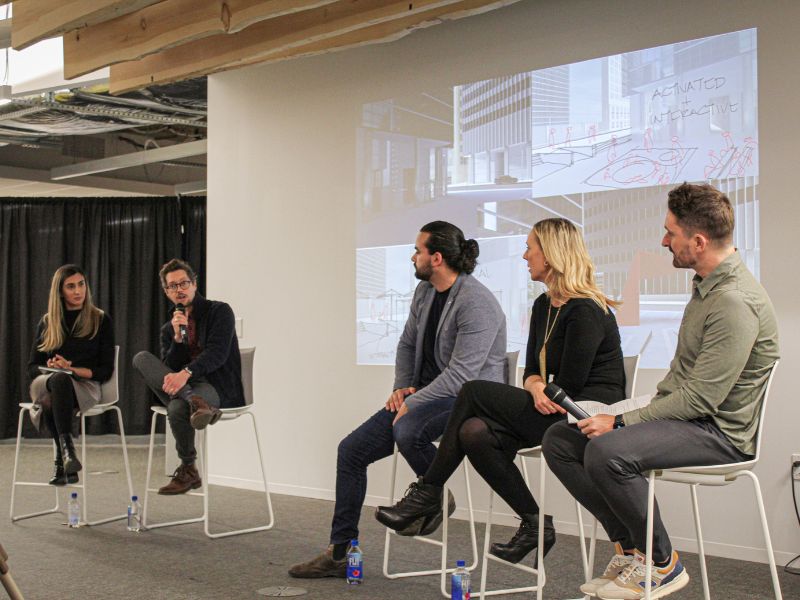Transdisciplinary study reveals positive impact of placemaking
In collaboration with four leading cultural and design institutions – The Daniels Corporation (external link, opens in new window) , Entro (external link, opens in new window) , Lemay (external link, opens in new window) and MASSIVart (external link, opens in new window) – The Creative School recently released key findings from a multi-year, comprehensive and transdisciplinary study: A New Bottom Line: The Value & Impact of Placemaking.
The team of educational researchers and industry leaders, including Creative Industries Associate Professor Dr. Louis-Etienne Dubois, set out to examine how intentionally shaping public and private spaces to maximize shared value, otherwise known as placemaking, can transform public spaces into dynamic meaning-making environments.

Immersive sculpture Hymn to the Big Wheel by Liz West. Curated and produced by MASSIVart for Brookfield Properties’ Arts Brookfield initiative.
Enriching public and private spaces to maximize visitor experience
Placemaking takes a multi-faceted approach to the design, organization and management of public and private spaces and seeks to enrich these spaces through collaborative processes. By examining the effects of art installations, cultural programming, interior design, place branding and architecture in public spaces, the study revealed significant findings about the benefits of placemaking, including that individuals are fifty percent more likely to spend time in spaces with creative placemaking.
“Placemaking is an effective way to elevate any space and strengthen the physical and emotional connection between the people and the places they share,” said Coralie Olson, Managing Partner, MASSIVart. “Our hope is that this study emphasizes the value of placemaking and leads to more impactful placemaking initiatives in Canada, which in turn supports the artistic community and makes art more accessible to the public.”

Lemay’s Escape 67 historic site renewal located in Montreal, Quebec. Photo credit; Marc Cramer
Placemaking can also significantly improve people's perceptions and positive feelings toward a given space while increasing an individual's likelihood of sharing information about the space with others. The study highlights that placemaking is a powerful tool to connect individuals and communities to built environments, whether it's an interactive art installation, a feat of architectural inspiration or a dynamic facade, and illustrates the importance of connecting people to places.
"Design is a powerful way to connect people to a place. This study shows that placemaking provides identity and meaning, allowing us to form emotional connections that inspire us to engage with a space," said Vedran Dzebic, Head of Research and Development, Entro.

Daniels Spectrum by The Daniels Corporation, Entro, Toronto Community Housing Corporation, Artscape and Diamond Schmitt Architects in collaboration with the Regent Park community, Toronto, Ontario. Photo credit: Lisa Logan
A transdisciplinary solution to a multi-faceted problem
The initial work on the study commenced in late 2020, and alongside its industry partners, involved five co-investigators: Jonathon Anderson from Interior Design, Frederic Dimanche from Hospitality and Tourism Management at the Ted Rogers School of Management (TRSM), Dogan Titiroglu from Real Estate at TRSM, Onur Bodur from Concordia University and Dr. Louis-Etienne Dubois. As Dr. Dubois highlights, the diverse range of educational and industry professionals speaks to the interdisciplinary nature of placemaking.
"Here you have scholars from interior design, marketing, finance, tourism and creative industries management getting together with a group of equally diverse industry practitioners to tackle a complex and multi-faceted question," stated Dr. Dubois. "Add to that the fact that four student research assistants from both creative industries and interior design worked on the study for months at a time, and you can begin to understand how attempting to measure what placemaking does can keep a lot of people busy."
It’s collaborative initiatives like these that build on and provide additional insight into developing purpose-built, meaning-making environments. “Space only becomes place once we find meaning in it, and that meaning is rooted in its quality of life for communities,” stated Rob Fiorino, Lemay’s Chief Marketing Officer.

Undulating façade of Arc Condominiums at Daniels Erin Mills designed by Kirkor Architects and Planners for The Daniels Corporation, Mississauga, Ontario. Photo credit; The Daniels Corporation
On Thursday, November 17, a panel was held at The Catalyst at The Creative School (opens in new window) to discuss these findings and celebrate the groundbreaking results. Presented by the lead researchers and industry partners, the event featured the diligent work of everyone involved and was met with positive reception. The scholarly version of the study is currently under revision at a peer-reviewed academic journal, with hopes of it being published at some point in 2023.

A New Bottom Line: the value and impact of placemaking panel at The Catalyst
Interested in learning more about the findings of this study? Watch the video trailer (external link) , the live panel (external link) , the manifesto (external link, opens in new window) and the press release (external link) to see the full list of details and key findings.
The Creative School at Toronto Metropolitan University
The Creative School is a dynamic faculty at Toronto Metropolitan University making a difference in new, unexplored ways. Comprised of Canada’s top professional schools and transdisciplinary hubs in media, communication, design and cultural industries, The Creative School offers students an unparalleled global experience in the heart of downtown Toronto.
